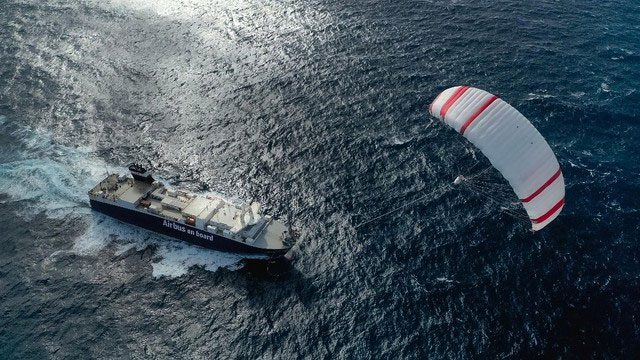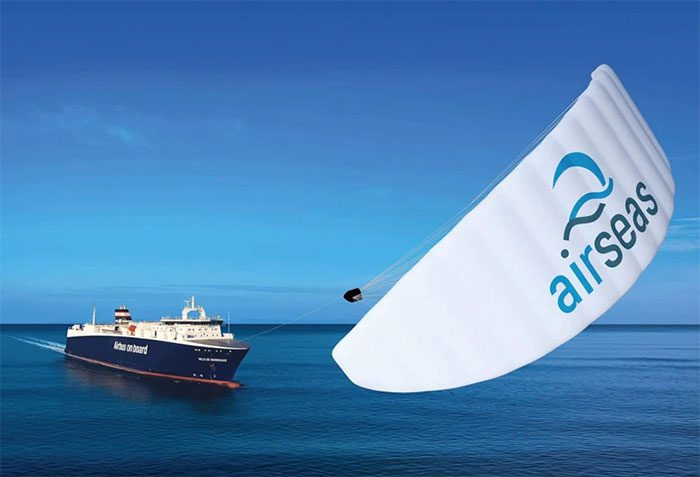The French company Airseas has developed a kite named Seawing, which they believe can tow a large cargo ship across the sea. This innovation reduces fuel consumption and carbon emissions by 20% for maritime cargo transport.
The Kite That Creates a “Revolution” in Emission Reduction
According to the International Maritime Organization, the shipping industry accounts for about 3% of global greenhouse gas emissions – which is why urgent changes are needed, said Vincent Bernatets, co-founder and CEO of Airseas.

Seawing kite tested on a cargo ship by Airbus.
Alternative fuels, such as green ammonia, are being developed, but they are expensive, and Bernatets argues that it will take decades before the infrastructure to deploy them on a large scale is in place.
“While we wait, what can we do?” he asked. “This is where the use of wind becomes crucial.”
While ships have been powered by wind for millennia, Seawing uses advanced technology to adapt this method for the 21st century. The kite functions like a parachute, similar to those used in kite surfing, and is deployed via a retractable mast, which is also used to reel in the kite and store it when not in use. The kite itself is controlled by automatic steering software operating from a box underneath the kite. This box is connected to the ship by a 700-meter long cable that provides power and transmits data to and from the ship.
“What sets it apart from other wind solutions is that the kite is not just pulled by the wind; the ship is also pulling it back,” said Bernatets.
“Instead, it flies in a figure-eight pattern, amplifying the drag effect of the airflow to generate what he calls ‘insane power.’”
“Additionally, we harness wind at an altitude of 300 meters above sea level, where it is 50% stronger.”
This combination “explains why we can generate tremendous power with a very compact, simple system at the bow of the ship that can be retrofitted to any vessel, not just new ones,” he added.
“Seawing,” a giant parafoil kite with an area of 250m², has been tested at sea for the first time. It successfully towed the Ville de Bordeaux, a bulk carrier with a deadweight tonnage of 21,528 tons, according to Interesting Engineering.
The company plans to conduct approximately six months of testing and trials before the ship embarks on a real transatlantic journey.
“We are proud to have a solution that can help ships reduce emissions right now, while also accelerating the decarbonization of the shipping industry in the coming years,” declared Vincent Bernatets, CEO of Airseas.
He also mentioned that the company has been working with several major shippers and has installed some Seawing systems on cargo ships.
Currently, Airseas has completed the installation of the first Seawing system for the customer “K” Line (Kawasaki Kisen Kaisha, Ltd).
This system was installed on a Capesize bulk carrier in December 2022, marking it as the first of five K Line vessels equipped with Seawing.
The 210,000 DWT bulk carrier, powered by LNG and built at Nihon Shipyard, will be the second vessel to feature Seawing. Installation will take place after the ship is delivered in 2024.

Airseas’ sail technology can be efficiently installed on ships in just a few days.
If the trials proceed smoothly as planned, Airseas will then move on to a different type of wing with a width exceeding 1,000 square meters that will fly at an altitude of 300 meters above sea level, cutting fuel consumption and emissions by approximately 20%. Their sail technology can be conveniently installed on ships within just a few days.
What is the Seawing Giant Kite Technology?
Seawing combines kite technology with an automatic flight control system developed by the aerospace industry to harness wind energy. This system helps reduce average emissions and fuel consumption of ships by 20%, according to the company.
The Seawing technology is mounted onto the ship and takes up minimal deck space. It can be installed on most types of vessels, without height restrictions, and does not obstruct cargo operations.
Kites or static sails generate only 1/10th of the pull compared to Seawing, which flies flexibly at speeds over 100 km/h in a figure-eight trajectory. The kite soars 200 meters in the air to catch stronger, more stable winds.
According to the International Windship Association, there will be 50 wind-powered ships by the end of 2023.


















































